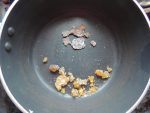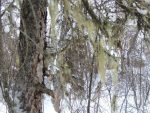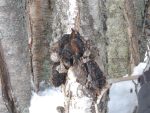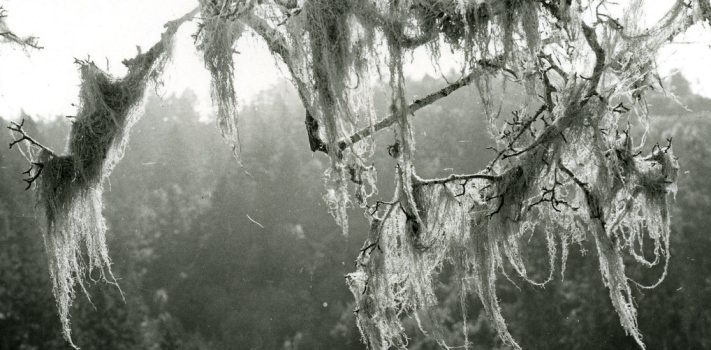Climbing the learning curve from “erstwhile city slicker” in Texas to remote rural life in Alaska, my acclimation has been immeasurably aided by several courses in botany, which have enhanced both gardening and foraging for food, home remedies, and construction materials. Currently, I am enrolled in a fascinating on-line course in Applied Ethnobotany. It is offered by the University of Alaska-Fairbanks.
As the name suggests, this field studies human use of plants – for food, fuel, textiles, shelter, medicine, and anything else. I am learning how indigenous peoples and settlers utilized the resources all around them, that other people, like me, surely overlook. Interested readers will see below a list of resources they may be able to utilize for their own regions.

At the very beginning of this course, our professor instructed us to harvest some local plants for several projects. Really? In February? In Alaska? What could I find this time of year? Well, duh, trees. I live in a forest! But besides use as firewood, construction, and spring birch sap, I did not know much. So one day, my husband and I pulled on our snowshoes and dragged a little plastic sled through the woods for a scavenger hunt. How fun! In half an hour, we gathered two species of pendulous (hair) lichen with the evocative colloquial names of “witch’s hair” and “bear hair,” chopped some chaga and “punk” conks off old birch trees, peeled off some loose birch bark, gathered a handful of frozen spruce resin globules, and cut a wrist-thick swath of sweet grass sticking up through shallow snow beneath the shelter of a large spruce tree.
With subsequent research, I realized that, even at this inhospitable time of year, in such a short period, I had harvested materials for medicine, food, cordage, insulation, padding, clothes, insect repellent, and containers. Wow! I am now absolutely hooked on ethnobotany.
The following is what I learned about this motley collection. What might you discover in your vicinity, even in winter?
 Such matted and absorbent HAIR LICHEN were commonly used for diapers, wound dressings, menstrual pads (I always wondered about that), insulation for both shelter and clothing, and padding/stuffing. Some groups made clothes and blankets with them. Others may have endured them as famine food, although they have few bio-available nutrients for people and several mycotoxins, too.
Such matted and absorbent HAIR LICHEN were commonly used for diapers, wound dressings, menstrual pads (I always wondered about that), insulation for both shelter and clothing, and padding/stuffing. Some groups made clothes and blankets with them. Others may have endured them as famine food, although they have few bio-available nutrients for people and several mycotoxins, too.
JWR Adds: Hair or Beard lichens have different names, regionally. Here in the American Redoubt, the most common variety is called Old Man’s Beard.
I may harvest some to augment potting soil, since it is nicely absorbent, and I have previously liked the lichen (and the twigs they dangle from) for rapidly igniting fire starters. Perhaps the most interesting thing I learned is that epiphytic lichen like these are the “canaries in the cold mine” that many forest services and scientists use to measure air pollution and climate change because, sadly, they are extirpated or rare in regions coated with acid rain and other pollutants.
 CHAGA (a burnt-looking sterile conk that grows on old birch trees) has an impressive pedigree as an immunity builder and anti-cancer medicine (it is commercialized in Russia, China, and Japan but not recognized by the US FDA) and for other conditions, with few contra-indications. In the boreal forest regions where it grows, it is a common alternative for coffee and tea. We drink it now, too. It has a pleasant, weak coffee sort of flavor.
CHAGA (a burnt-looking sterile conk that grows on old birch trees) has an impressive pedigree as an immunity builder and anti-cancer medicine (it is commercialized in Russia, China, and Japan but not recognized by the US FDA) and for other conditions, with few contra-indications. In the boreal forest regions where it grows, it is a common alternative for coffee and tea. We drink it now, too. It has a pleasant, weak coffee sort of flavor.
The smooth PUNK CONKs that appear on the E and N sides of old and dying birches have been used as a smoking insect repellent, which I totally want to try this summer. Maybe I can replace those noxious chemical burn coils!
BIRCH BARK confers a sweet and tasty flavor to tea, with some reputed medicinal benefits, too, for headaches and pain. The bark is waterproof and rather easy to work to make various containers, from baskets to canoes. Several years ago, with the able instruction of a talented teacher, I made a table of birch and willow, topped with birch bark, that has stood the test of several year’s daily use.
SPRUCE RESIN drips on the south sides of spruce trees, in skinny golden lines. This time of year, it is easy to chip off a handful at a time with one’s fingernail and store in a jar. Melted, it can waterproof clothes and containers. As medicine, it has been inhaled as a steam, drunk in tea, or chewed like a gum, to fight respiratory ailments. To me, it smells better than it tastes, and the flavor lingers in the mouth, tainting subsequent foods, but, like other resinous substances, it certainly does induce breathing deeply!
SWEET GRASS was the least useful thing I harvested this time of year. In summer, its aromatic suppleness can be woven into all sorts of practical and decorative pieces, but my little winter braid was, of course, dry and brittle. Some people make/buy/sell sweet grass “smudges” – like incense, but my first efforts at this were unimpressive.
Courses and research like this really open my eyes to appreciate, for example, the gnarly growths on aged, first-growth birch trees, and the pendulous lichen that coat the spruce branches. How clever (or motivated) were the ancestors who figured out how to use the resources around them. Bit by bit, lesson by life lesson, I am learning to take fewer things at face value, including my woods.
For Further Reading
Recommended resources that have been invaluable to me:
Master Gardener Course (semester-long, through a local university or community extension agent)
Permaculture Course (semester-long, international curriculum, in-person or on-line)
Native Plant Societies/Herbal Societies
www.theherbalacademy.com (semester and short courses, on-line)
www.eattheweeds.com excellent foraging articles, searchable database
Ethnobotany departments exist in some universities (or look within the botany departments)
Citizen Scientist opportunities, through state Departments of Natural Resources
the Native American Ethnobotany Database ( www.naeb.brit.org)










